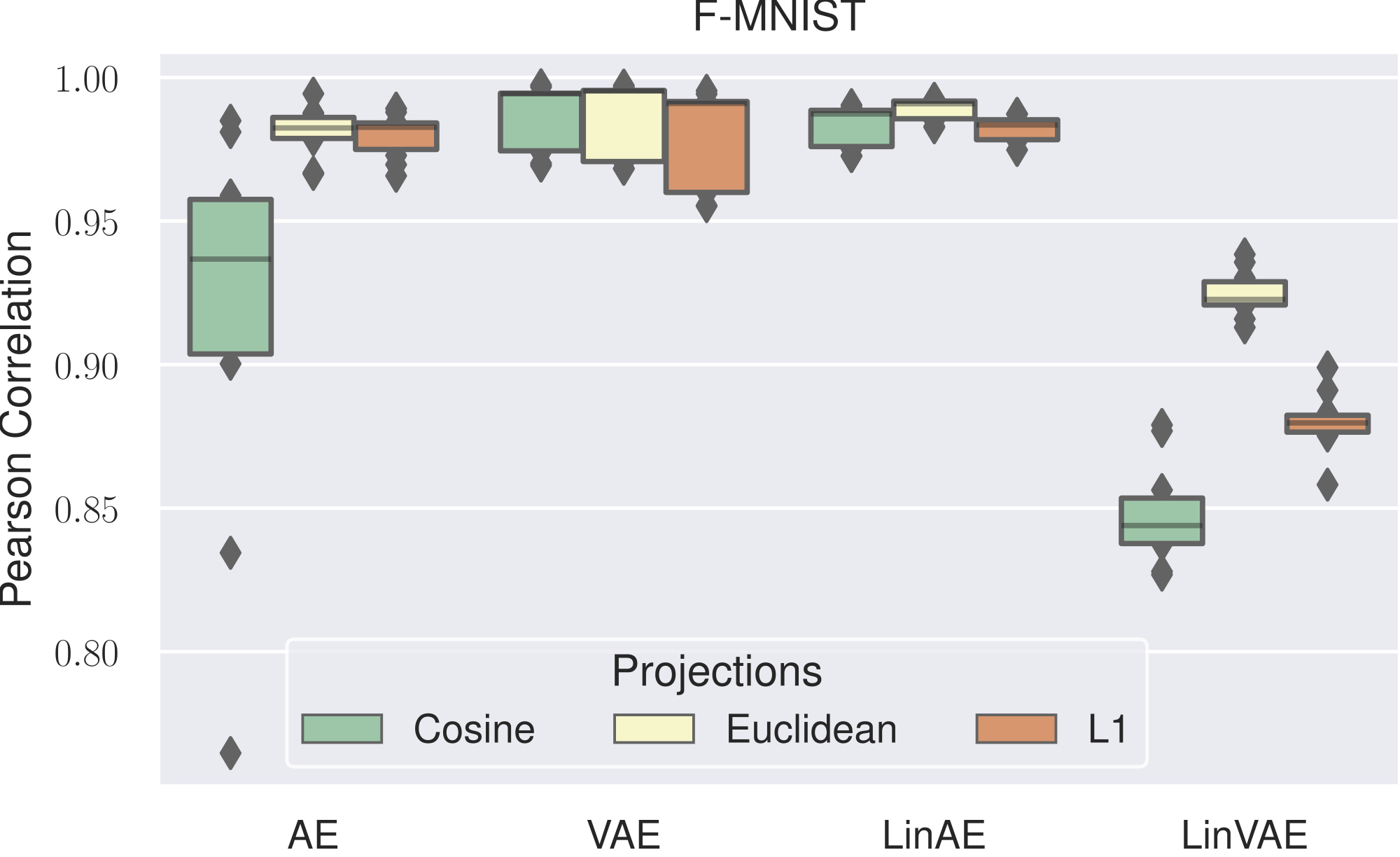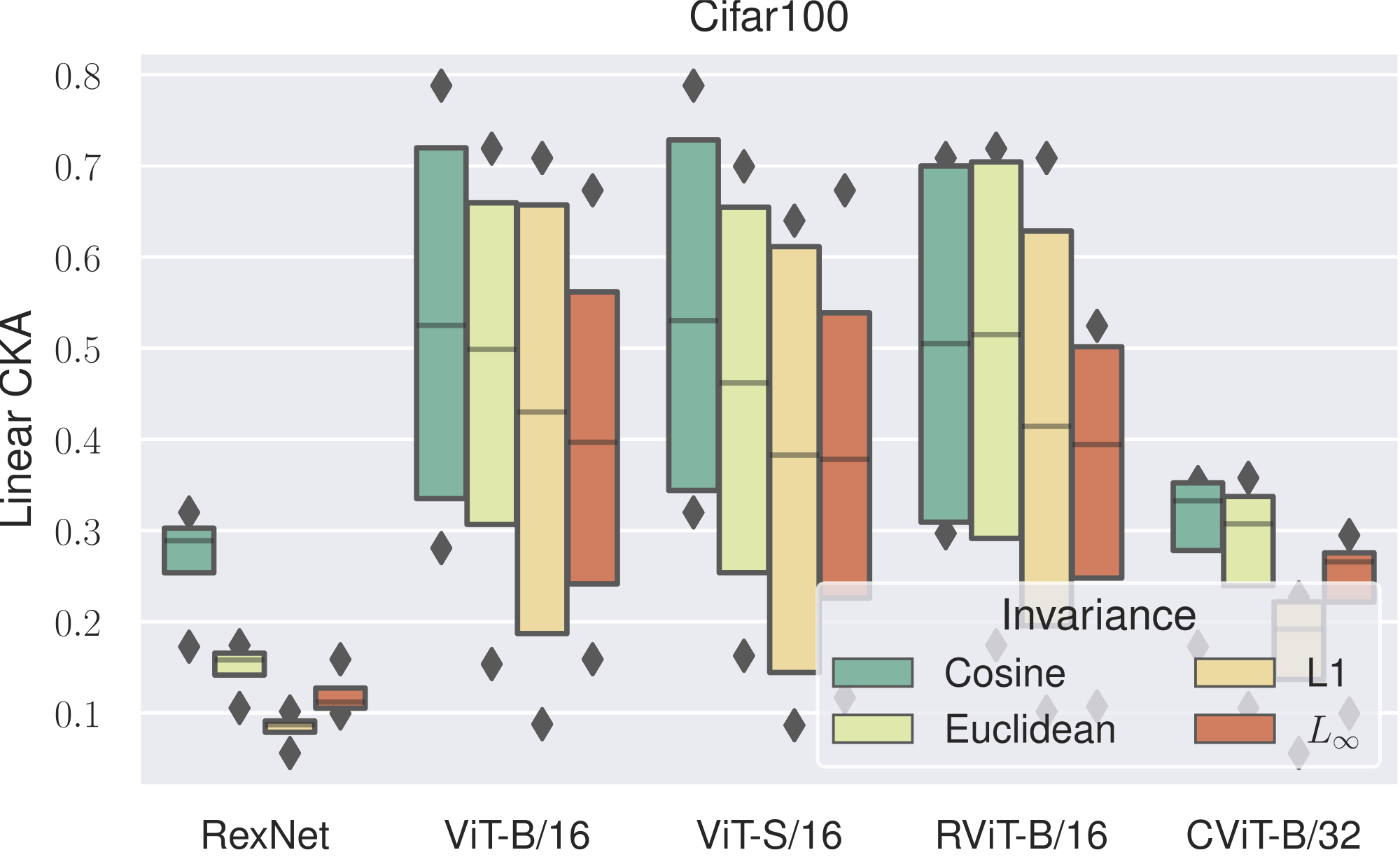Overview
Neural networks trained under similar inductive biases often learn representations with hidden structural similarities—yet connecting these latent spaces remains challenging. The transformations relating different networks vary unpredictably based on initialization, architecture, dataset, and training dynamics. From Bricks to Bridges introduces a versatile framework that doesn’t require knowing the transformation class a priori.
Instead of committing to a single invariance (e.g., angle-preserving transformations), we construct a product space of multiple relative representations, each induced by different distance metrics: Cosine, Euclidean, L1, and L∞. By combining these complementary invariances, we capture complex, nontrivial transformations that enable zero-shot model stitching across architectures, modalities, and training conditions.

Method: Product of Invariances
The Challenge
When two neural networks learn similar tasks, their latent spaces are related by some transformation T. However, this transformation varies based on:
- Random initialization and training dynamics
- Architectural differences (CNN vs Transformer, AE vs VAE)
- Dataset characteristics (MNIST vs CIFAR vs text vs graphs)
- Training objectives (reconstruction vs contrastive learning)
Traditional approaches assume a single metric (typically cosine similarity for angle-preserving transformations) captures this relationship. Our experiments show this assumption fails systematically.
Our Solution: Product Space Framework
We approximate the unknown manifold where representations align by constructing a product space:
\[\tilde{\mathcal{M}} := \prod_{i=1}^N \mathcal{M}_i\]Each component \(\mathcal{M}_i\) is a relative representation space induced by a different similarity function \(d_i\) (Cosine, Euclidean, L1, L∞), capturing invariances to different transformation classes.

Relative Representations with Multiple Metrics
Given an encoder \(E: \mathcal{X} \to \mathcal{Z}\), anchors \(\mathcal{A} \subset \mathcal{X}\), and similarity function \(d\), the relative representation is:
\[\text{RR}(z; \mathcal{A}, d) = \bigoplus_{a_i \in \mathcal{A}} d(z, E(a_i))\]We construct four such spaces using:
- Cosine: Invariant to angle-preserving transformations (rotations + uniform scaling)
- Euclidean: Invariant to orthogonal transformations (rotations + reflections)
- L1: Invariant to axis-aligned transformations
- L∞: Invariant to coordinate-wise scaling
Aggregation Strategies
We combine these spaces using:
MLP+Sum (Default): Inspired by DeepSets, independently normalize and project each space via MLP (LayerNorm + Linear + Tanh), then sum the results. This maintains constant dimensionality while allowing the model to learn optimal weightings.
Alternatives: Concatenation (increases dimensionality) or Self-Attention (requires fine-tuning for best performance).
Experiments
1. Latent Space Analysis: No Universal Metric
Setup: We analyze cross-seed similarity for models trained from scratch (Autoencoders on MNIST, CIFAR-10/100, Fashion-MNIST) and cross-architecture similarity for pretrained foundation models (5 vision models, 7 text models).


Key Finding: The optimal metric changes systematically based on architecture, dataset, and training conditions. This variability motivates combining multiple metrics rather than choosing one a priori.
2. Zero-Shot Model Stitching
Setup: We perform zero-shot stitching where an encoder from one model is combined with a decoder from another, mediated by our product space representation. No fine-tuning or training occurs—the stitching is entirely zero-shot.
Vision Classification (CIFAR-10/100, MNIST, Fashion-MNIST):
The product of invariances consistently matches or exceeds the best single metric, without prior knowledge of which metric to use.
| Encoder | Projection | CIFAR-100 | CIFAR-10 | MNIST | F-MNIST |
|---|---|---|---|---|---|
| CViT-B/32 | Cosine | 0.52±0.03 | 0.87±0.02 | 0.61±0.06 | 0.68±0.02 |
| Euclidean | 0.53±0.02 | 0.87±0.02 | 0.66±0.05 | 0.70±0.03 | |
| L1 | 0.53±0.04 | 0.87±0.02 | 0.66±0.05 | 0.70±0.03 | |
| L∞ | 0.27±0.04 | 0.52±0.04 | 0.57±0.03 | 0.55±0.01 | |
| Product (All 4) | 0.58±0.03 | 0.88±0.02 | 0.68±0.05 | 0.70±0.01 | |
| RViT-B/16 | Cosine | 0.79±0.03 | 0.94±0.01 | 0.69±0.04 | 0.76±0.03 |
| Euclidean | 0.79±0.03 | 0.94±0.01 | 0.71±0.04 | 0.77±0.03 | |
| L1 | 0.77±0.04 | 0.95±0.01 | 0.71±0.04 | 0.79±0.03 | |
| L∞ | 0.31±0.03 | 0.75±0.04 | 0.61±0.05 | 0.60±0.03 | |
| Product (All 4) | 0.81±0.04 | 0.95±0.01 | 0.72±0.04 | 0.76±0.04 |
Text & Graph Classification:
| Modality | Encoder | Projection | DBPedia | TREC | CORA | Stitching Index |
|---|---|---|---|---|---|---|
| Text | ALBERT | Cosine | 0.50±0.02 | 0.54±0.03 | - | - |
| Euclidean | 0.50±0.00 | 0.60±0.03 | - | - | ||
| L1 | 0.52±0.01 | 0.65±0.02 | - | - | ||
| L∞ | 0.18±0.02 | 0.29±0.06 | - | - | ||
| Product | 0.53±0.01 | 0.65±0.02 | - | - | ||
| Graph | GCN | Cosine | - | - | 0.53±0.06 | 0.71 |
| Euclidean | - | - | 0.27±0.06 | 0.58 | ||
| L1 | - | - | 0.26±0.06 | 0.58 | ||
| L∞ | - | - | 0.12±0.03 | 1.00 | ||
| Product | - | - | 0.77±0.01 | 1.00 |
Stitching Index = stitching accuracy / end-to-end accuracy. A value of 1.0 means zero-shot stitching matches end-to-end training.
Remarkable: On CORA graphs, the product space achieves perfect stitching (index 1.0) with 77% accuracy, dramatically outperforming the best single metric (53%).
3. Zero-Shot Image Reconstruction
Setup: Autoencoder image reconstruction on CIFAR-100, stitching encoders and decoders from different training seeds.

Quantitative Results:
| Projection | L1 Error | MSE |
|---|---|---|
| Cosine | 0.06±0.02 | 0.20±0.03 |
| Euclidean | 0.01±0.00 | 0.06±0.00 |
| L1 | 0.01±0.00 | 0.09±0.00 |
| L∞ | 0.03±0.01 | 0.14±0.01 |
| Product (All 4) | 0.01±0.00 | 0.06±0.00 |
| Product (without L∞) | 0.02±0.00 | 0.10±0.01 |
| Absolute (no relative) | 0.26±0.06 | 0.43±0.06 |
Key Insight: L∞ alone produces blurry images, but removing it from the product space degrades performance. This demonstrates that metrics capture complementary information—even poorly-performing ones contribute crucial details.
4. Ablation: Aggregation Functions
We compare different strategies for combining the four relative spaces:
| Aggregation | Vision (RViT-B/16) | Text (BERT-C) | Graph (GCN) |
|---|---|---|---|
| Concat* | 0.81±0.00 | 0.54±0.03 | 0.75±0.02 |
| MLP+SelfAttention | 0.84±0.01 | 0.51±0.03 | 0.63±0.13 |
| MLP+Sum | 0.85±0.00 | 0.55±0.04 | 0.77±0.01 |
| SelfAttention | 0.76±0.03 | 0.36±0.22 | 0.76±0.02 |
*Concat increases dimensionality, not directly comparable.
MLP+Sum wins across all modalities: the preprocessing step (normalization + projection) is critical, and simple sum aggregation outperforms complex attention mechanisms in zero-shot settings.
5. Space Selection via Fine-tuning
Setup: Can we learn which spaces are most valuable? We fine-tune only the attention mechanism’s QKV parameters (responsible for blending spaces) on RexNet→ViT-B/16 stitching for CIFAR-100.
| Configuration | Accuracy |
|---|---|
| Cosine (best single metric) | 0.50 |
| Product + Zero-shot SelfAttention | 0.17 |
| Product + Zero-shot MLP+Sum | 0.45 |
| Product + Fine-tuned QKV | 0.75 |
| Product + Fine-tuned MLP (classifier) | 0.52 |

Key Finding: Fine-tuning how spaces are weighted (QKV) is more effective than fine-tuning the task-specific classifier. This validates that the product space creates a rich representational substrate where proper “alchemical weighting” of invariances is crucial.
Key Findings
-
No universal metric exists: The optimal similarity function varies systematically with architecture, dataset, task, and training conditions.
-
Complementarity is pervasive: Even poorly-performing metrics (L∞) capture information not present in others. Combining metrics consistently outperforms any single choice.
-
Zero-shot effectiveness: The method enables zero-shot model stitching without training, sometimes achieving perfect stitching indices (1.0 on graphs).
-
Modality-agnostic: Works across vision (CNNs, ViTs, CLIP), text (BERT family), and graphs (GCNs) with consistent improvements.
-
Practical robustness: Performance advantage holds across varying hyperparameters (anchor counts, aggregation strategies), making it practical without extensive tuning.
-
Learnable space selection: When fine-tuning is possible, learning space weightings is more impactful than tuning task-specific layers.
Citation
@inproceedings{cannistraci2024bricks,
title = {From Bricks to Bridges: Product of Invariances to Enhance Latent Space Communication},
author = {Cannistraci, Irene and Moschella*, Luca and Fumero*, Marco and
Maiorca, Valentino and Rodol{\`a}, Emanuele},
booktitle = {International Conference on Learning Representations},
year = {2024},
url = {https://openreview.net/forum?id=vngVydDWft}
}
Authors
Irene Cannistraci · Luca Moschella* · Marco Fumero* · Valentino Maiorca · Emanuele Rodolà
*Equal Contribution
Sapienza University of Rome, Italy